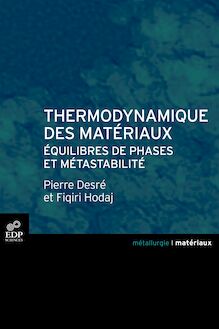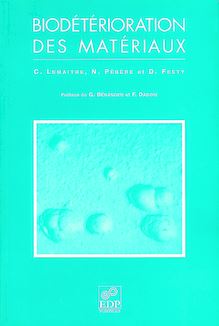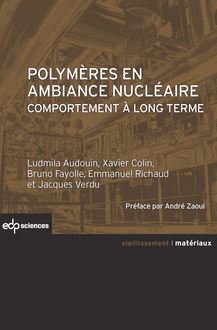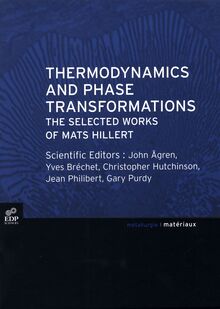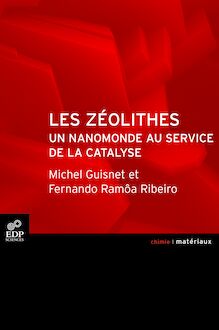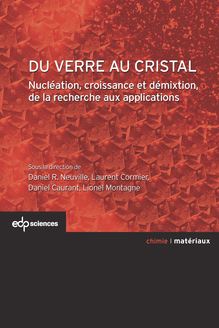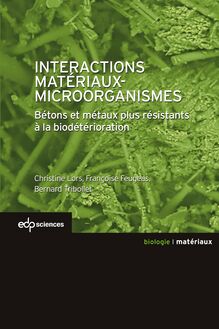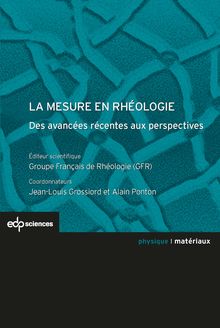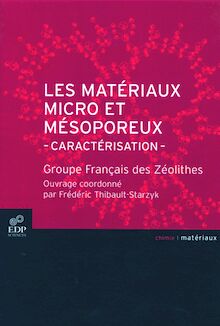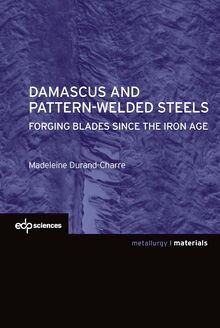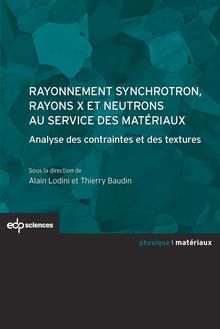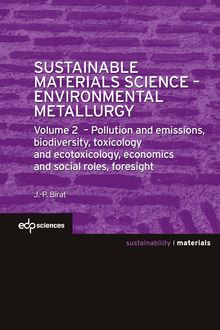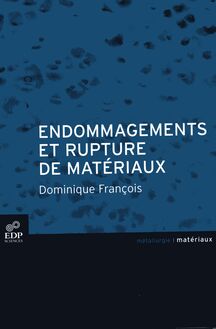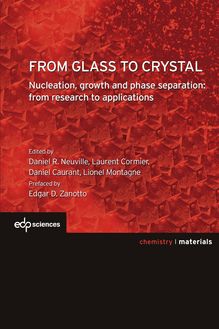Sustainable Materials Science - Environmental Metallurgy , livre ebook
501
pages
English
Ebooks
2020
Obtenez un accès à la bibliothèque pour le consulter en ligne En savoir plus
Découvre YouScribe en t'inscrivant gratuitement
Découvre YouScribe en t'inscrivant gratuitement
501
pages
English
Ebooks
2020
Obtenez un accès à la bibliothèque pour le consulter en ligne En savoir plus
Publié par
Date de parution
04 mars 2020
Nombre de lectures
0
EAN13
9782759824434
Langue
English
Poids de l'ouvrage
15 Mo
Materials are at the core of our societies and of our economies. They are part of pressing environmental challenges but they also provide powerful answers. It is therefore no longer possible to think of materials from the restricted standpoint of Materials and Engineering Sciences and this book proposes a more holistic vision of their connection with the Environment and with Society.
The book is meant for students, researchers, engineers, and concerned citizens interested in how materials, nature and people interact: at the level of raw materials and energy resources, of innovation and emergence of new materials functions, of historical continuity with materials of the past, and of emissions to air, water and soil and thus in connection also with health and toxicology issues, climate change and collapse of biodiversity. The book examines how materials relate to society with complex metrics, but also, more deeply, how they generate eco-social services, and, finally, have agency along with the people who use them and invent them (Actor Network Theory).
This book is unique in its approach across so many fields. There are many excellent treatises on materials science and more on industrial ecology. However, the connection with the social dimension of sustainability is still rarely discussed and the pluridisciplinary cocktail of approaches used here is truly new.
Publié par
Date de parution
04 mars 2020
Nombre de lectures
0
EAN13
9782759824434
Langue
English
Poids de l'ouvrage
15 Mo
SUSTAINABLE MATERIALS SCIENCE
ENVIRONMENTAL METALLURGY
Volume 1 – Origins, basics, resource and energy needs
J.-P. Birat
Materials are at the core of our societies and of our economies. They are part of pressing environmental SUSTAINABLE challenges but they also provide powerful answers. It is therefore no longer possible to think of materials
from the restricted standpoint of Materials and Engineering Sciences and this book proposes a more holistic
vision of their connection with the Environment and with Society. MATERIALS SCIENCE –
The book is meant for students, researchers, engineers, and concerned citizens interested in how materials,
nature and people interact: at the level of raw materials and energy resources, of innovation and emergence ENVIRONMENTAL of new materials functions, of historical continuity with materials of the past, and of emissions to air, water
and soil and thus in connection also with health and toxicology issues, climate change and collapse of
biodiversity. The book examines how materials relate to society with complex metrics, but also, more deeply, METALLURGYhow they generate eco-social services, and, fnally, have agency along with the people who use them and
invent them (Actor Network Theory).
This book is unique in its approach across so many felds. There are many excellent treatises on materials Volume 1 – Origins, basics, V, basics,
science and more on industrial ecology. However, the connection with the social dimension of sustainability
is still rarely discussed and the pluridisciplinary cocktail of approaches used here is truly new. resource and energy needs
Jean-Pierre Birat is a metallurgist, who discovered environmental issues as a researcher with a major
steel producer. He is a graduate of the Paris School of Mines and UC Berkeley. He has worked in France
(IRSID, ArcelorMittal Research)), Japan and Belgium (ESTEP), headed the ULCOS program and has been
organizing the “Materials and Society” conferences for 14 years. He teaches the content of this book at
the University of Science and Technology of Beijing.
J.-P. Birat
ISBN : 978-2-7598-2198-3 / 129 €
www.edpsciences.org
9782759 821983
materials I sustainability sustainability I materials
SUSTAINABLE MATERIALS SCIENCE
– Volume 1 J.-P. Birat
ENVIRONMENTAL METALLURGYSuStainable MaterialS Science -
environMental Metallurgy
Volume 1
Origins, basics, resources & energy needsSuStainable MaterialS Science -
environMental Metallurgy
Volume 1
Origins, basics, resources & energy needsSuStainable MaterialS Science -
environMental Metallurgy
Volume 1
Origins, basics, resources & energy needsIf further generations are to remember us more with gratitude
than sorrow, we must achieve more than just the miracles of
technology. We must also leave them a glimpse of the world as it
was created, not just as it looked when we got through with it.
Lyndon Baines Johnson
Printed in France.
© 2020, EDP Sciences, 17, avenue du Hoggar, BP 112, Parc d’activites de Courtaboeuf,
91944 Les Ulis Cedex A, France
This work is subject to copyright. All rights are reserved, whether the whole or part
of the material is concerned, specifcally the rights of translation, reprinting, re-use of
illustrations, recitation, broad-casting, reproduction on microflms or in other ways, and
storage in data bank. Duplication of this publication or parts thereof is only permitted
under the provisions of the French Copyright law of March 11, 1957. Violations fall
under the prosecution act of the French Copyright law.
ISBN (print): 978-2-7598-2198-3 – ISBN (ebook): 978-2-7598-2443-4Table of contents
Foreword . . . . . . . . . . . . . . . . . . . . . . . . . . . . . . . . . . . . . . . . . . . . . . XI
Preface . . . . . . . . . . . . . . . . . . . . . . . . . . . . . . . . . . . . . . . . . . . . . . . . . XV
CChapte h p Introduction: Man and Nature . . . . . . . . . . . . . . . . . . . . . 1
abstract . . . . . . . . . . . . . . . . . . . . . . . . . . . . . . . . . . . . . . . . . . . . . . . . . . . . 2
1. connection between man and nature: demography
and economy . . . . . . . . . . . . . . . . . . . . . . . . . . . . . . . . . . . . . . . . . . . 4
2. the connection between Man and nature in various
cultures and religions . . . . . . . . . . . . . . . . . . . . . . . . . . . . . . . . . . . . 6
3. the “ecological Footprint” of the world . . . . . . . . . . . . . . . . . . . . . 8
4. the planet as a series of “spheres”, an ecological
categorization . . . . . . . . . . . . . . . . . . . . . . . . . . . . . . . . . . . . . . . . . . . 10
5. the concept of Sustainable Development . . . . . . . . . . . . . . . . . . . . 11
6. Sustainable Development and the spheres model . . . . . . . . . . . . . . 16
7. Sustainability and sciences . . . . . . . . . . . . . . . . . . . . . . . . . . . . . . . . 18
8. organization of the book . . . . . . . . . . . . . . . . . . . . . . . . . . . . . . . . . 20
9. conclusions of chapter 1 25
10. other itineraries to explore this book . . . . . . . . . . . . . . . . . . . . . . . 26
appendix 1. gDP evolution over historical time scales . . . . . . . . . . . . . . 31
a 2. Mandate of the brundtland commission
(un, December 1983). . . . . . . . . . . . . . . . . . . . . . . . . . . . . . . . . . . . 32
11. bibliography . . . . . . . . . . . . . . . . . . . . . . . . . . . . . . . . . . . . . . . . . . . . 32
11.1. Journals. . . . . . . . . . . . . . . . . . . . . . . . . . . . . . . . . . . . . . . . . . 32
11.2. Books, reports. . . . . . . . . . . . . . . . . . . . . . . . . . . . . . . . . . . . . . 33
11.3. Websites, blogs, etc.. . . . . . . . . . . . . . . . . . . . . . . . . . . . . . . . . . 33
11.4. Conferences . . . . . . . . . . . . . . . . . . . . . . . . . . . . . . . . . . . . . . . 33
12. references . . . . . . . . . . . . . . . . . . . . . . . . . . . . . . . . . . . . . . . . . . . . . 34VI Sustainable Materials Science - Environmental Metallurgy
CChapte h p Introduction to aspects of Metallurgy and Materials
Science relevant to Sustainability . . . . . . . . . . . . . . . . . . . . . . . . . . . . . . 37
abstract . . . . . . . . . . . . . . . . . . . . . . . . . . . . . . . . . . . . . . . . . . . . . . . . . . . . 37
1. introduction. . . . . . . . . . . . . . . . . . . . . . . . . . . . . . . . . . . . . . . . . . . . 40
2. Metals in the vernacular language . . . . . . . . . . . . . . . . . . . . . . . . . . 41
3. Metals as chemical elements and substances . . . . . . . . . . . . . . . . . . 42
4. the nature of Materials . . . . . . . . . . . . . . . . . . . . . . . . . . . . . . . . . . . 45
5. Metals and especially iron in the universe . . . . . . . . . . . . . . . . . . . 46
6. Metals, iron and life. . . . . . . . . . . . . . . . . . . . . . . . . . . . . . . . . . . . . 52
7. a metallurgical narrative. . . . . . . . . . . . . . . . . . . . . . . . . . . . . . . . . . 53
7.1. Basics . . . . . . . . . . . . . . . . . . . . . . . . . . . . . . . . . . . . . . . . . . . 53
7.2. Materials production . . . . . . . . . . . . . . . . . . . . . . . . . . . . . . . . 55
7.3. Material properties 59
7.4. Utilization of steel in manufacturing and life cycle of steel . . . . . 62
7.5. Making, shaping & forming technologies – material concepts
used outside of the steel sector and in neighboring ones. . . . . . . . 63
7.6. Steel grades . . . . . . . . . . . . . . . . . . . . . . . . . . . . . . . . . . . . . . . 65
7.7. Innovation in steel metallurgy . . . . . . . . . . . . . . . . . . . . . . . . . 76
7.8. gy driven by Materials Science. . . . . 78
8. conclusions of chapter 2 . . . . . . . . . . . . . . . . . . . . . . . . . . . . . . . . . 80
appendix 1. iron in 100 languages (generated by google ranslate)t . . . 82
appendix 2. etymology of the words iron and steel. . . . . . . . . . . . . . . . . 83
a 3. Dictionary and encyclopedia defnitions of metals . . . . . . . 83
appendix 4. iron in the universe, on earth and in the cr . . . . . . . . . . ust 85
a 5. t ransferrin. . . . . . . . . . . . . . . . . . . . . . . . . . . . . . . . . . . . . . . 85
appendix 6. Steels for automotive applications . . . . . . . . . . . . . . . . . . . . 86
9. bibliography . . . . . . . . . . . . . . . . . . . . . . . . . . . . . . . . . . . . . . . . . . . . 90
10. references . . . . . . . . . . . . . . . . . . . . . . . . . . . . . . . . . . . . . . . . . . . . . 91
CChapte h p Materials and tools, a historical perspective
from prehistorical times until the present . . . . . . . . . . . . . . . . . . . . . . . 97
abstract . . . . . . . . . . . . . . . . . . . . . . . . . . . . . . . . . . . . . . . . . . . . . . . . . . . . 97
1. introduction 100
2. Society and Materials: how it all started, a few million years ago . . 102
2.1. Introduction . . . . . . . . . . . . . . . . . . . . . . . . . . . . . . . . . . . . . . 102
2.2. Prolegomena 102
2.3. Materials (and tools) . . . . . . . . . . . . . . . . . . . . . . . . . . . . . . . . 111
2.4. (Tools and) materials . . . . . . . . . . . . . . . . . . . . . . . . . . . . . . . . 118
2.5. Anthropoids and Materials. . . . . . . . . . . . . . . . . . . . . . . . . . . . 127
2.6. Conclusions to section 2 . . . . . . . . . . . . . . . . . . . . . . . . . . . . . . 129
3. History of metal technologies 131
3.1. Reminder of the previous section . . . . . . . . . . . . . . . . . . . . . . . . 131
3.2. Early metals. . . . . . . . . . . . . . . . . . . . . . . . . . . . . . . . . . . . . . . 132
3.3. Historical Metallurgy – Prereduced iron and Cemented Steel . . . 134Table of contents VII
3.4. Historical metallurgy – Pig Iron and Blast Furnaces . . . . . . . . . 139
3.5. gy: modern steelmaking, Bessemer, Thomas,
Martin & Héroult. . . . . . . . . . . . . . . . . . . . . . . . . . . . . . . . . . 149
3.6. The Steel Industry of the 20th & 21st century. . . . . . . . . . . . . . 150
3.7. Production
